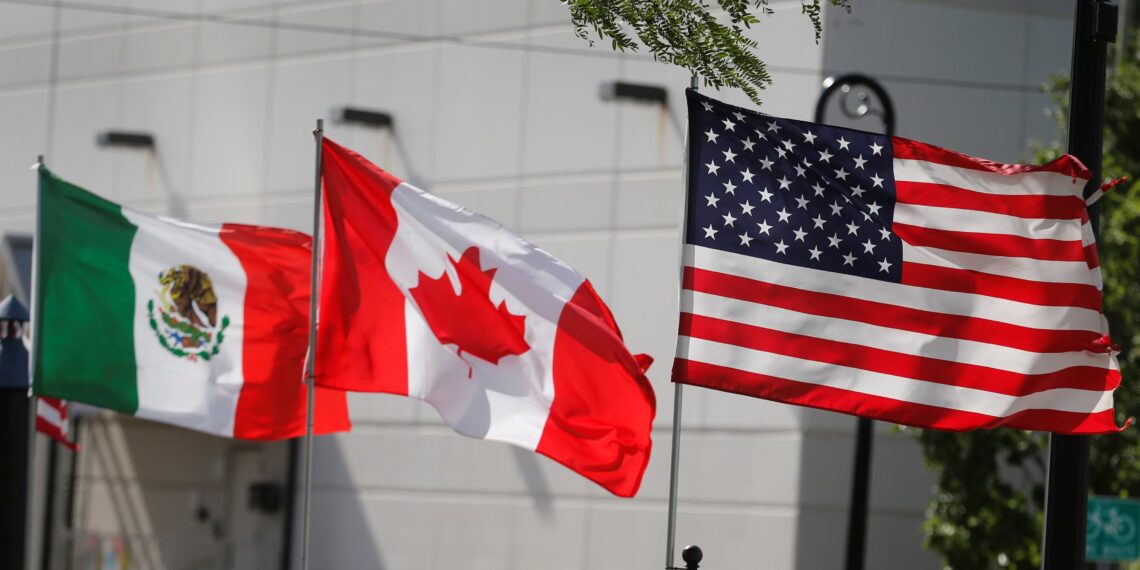By John F. Di Leo, Opinion Contributor
President Trump has made his first big move on the tariff front, with an announcement of a new 25% tariff on all imports from Canada and Mexico, and a new 10% tariff on all imports from China.
Both the business and mainstream press, predictably, jumped on the opportunity to quote economists who would claim that tariffs always cause inflation, hurt the consumer, and are politically unpopular, literally the worst thing you can do.
After watching the four-year train wreck of the Biden-Harris regime, one is likely to temper one’s response to such an announcement. After a regime that abandoned Afghanistan, funded anti-Israel terrorists, invited some ten million criminals into the country, implemented regulations designed to completely wreck our auto, energy, retail, and agricultural industries, and printed so much money it caused crippling, record-breaking inflation, we can look at a tax increase on imported goods with a bit of a calmer approach. Whatever damage it may do, it certainly won’t rise to the level of anything the Biden-Harris regime did.
But that’s not necessarily to say it’s a good thing either. This is a first volley in President Trump’s second term trade plans; we don’t know the end game yet.
Perhaps we should begin with a review of some of the inside baseball in international trade.
Import duties are the most common tariffs. Every country on earth has a program for assessing duties on goods that are imported from other countries. Thanks to the standardization processes implemented by the WCO and then the WTO in the 1980s, virtually all countries use the same coding system, known as the Harmonized Tariff.
This system divides all the products in the world into a huge book of shared coding practices. In the typical ten-digit code for each individual product, the first six digits are shared globally, and then every country adds a final four digits (sometimes five) to further divide out the item for statistical or taxing purposes. The USA’s book, if you’re interested in some bedtime reading, is found at hts.usitc.gov.
For example, all over the world, 7318.15 represents screws, bolts, nuts, and similar fasteners of iron or steel, and then every country adds four or five more digits to divide that group further, into steel machine screws, coach screws, bolts, nuts, and more. Some countries divide it into self-tapping and not self-tapping, some divide them between those under 6mm in diameter and those 6mm or over, some divide them between Philips head and slotted head and hex head, between regular steel and stainless steel, etc.
And all these subdivisions may or may not have different duty rates. In the USA, steel bolts, machine screws and studs are duty-free, many screws under 6mm in diameter are 6.2%, many screws 6mm and over are 8.5%, and that’s just a couple of pages of this massive book. Every imaginable product, from machines and appliances to components and raw materials, are similarly subdivided into the 98 chapters of a book that’s three or four inches thick, printed in very small font, and is revised every few months.
Some countries have generally lower duty rates than the USA does. Most have higher duty rates, on average, though it does depend on the subject area. Different countries protect different industries in different ways – textiles, machines, foods and beverages, raw materials, electrical components – traditionally, if your country specialized in something, you would protect that industry with high tariffs, and if you couldn’t produce it yourself, you would make it duty free so your constituents could afford to import them. But as cargo transportation has become easier, anyone can get anything now, and the massive mishmash of different duty rates seems almost incomprehensible and is certainly very difficult for economists and statisticians to analyze.
Besides, the duty rate isn’t the only thing charged on imported goods. There are a host of other charges upon importation, both in other countries and here in the USA.
When we import into the USA, almost all shipments are subject to a tiny fee – Customs’ Merchandise Processing Fee of about a third of a percent of the goods’ value. And if the goods arrive at a USA seaport (as opposed to arriving by air, truck, or rail), they are subject to a Port Maintenance Fee of another eighth of a percent. Together, these fees total just under half a percent of the total shipment value.
Some products are subject to complex additional taxes: Hard liquor, for example, gets hit with a huge IRS excise tax, often $13.50 per proof gallon (yes, that means it’s only assessed on the alcohol content!).
Products that have been identified as underpriced due to illegal subsidies from their origin country’s government are subject to anti-dumping or countervailing duties of 50%, 100%, even 200% or more, depending on the level of government subsidies involved.
And during the first Trump administration, two sets of additional tariffs were established, the Section 232 tariffs on most imported steel or aluminum raw materials (bar, sheet, rod, wire, tube, etc.), and the Section 301 punitive tariffs on imported goods made in China, While many of the steel and aluminum tariffs wound up being replaced by quota programs, the punitive China tariffs are still in place: most are 25%, some are 7.5%, and many other products were untouched by this one.
One final note to be aware of: the USA participates in numerous free trade agreements (FTAs), some reciprocal, some one-way, which cause qualifying goods to be duty-free. The hard part is qualifying. The “rules of origin” of these programs are designed to reward products made mostly in-country, with a minimal number of imported materials; if something doesn’t meet that standard, it doesn’t deserve the duty-free benefit.
These FTA requirements, unfortunately, are largely misunderstood, so duty-free benefits under the USMCA (formerly known as NAFTA) and other such programs are often claimed incorrectly, then prosecuted as fraud when the government realizes the benefits were illegitimately taken.
In recent years, this has been a serious problem in Mexico and Canada, as their manufacturers buy more and more Chinese parts for the products they make, not realizing that these Chinese-sourced components often kill their ability to qualify for duty-free treatment under the USMCA.
These free trade agreements – USMCA, DR-CAFTA, KORUS, and others – only exempt a product from duty (and occasionally a Customs fee or two), not the rest of these taxes.
Tariffs and other import taxes are stackable; being exempt from one just removes that one; the rest may still apply.
So, now that we have that foundation in place, let’s read today’s news in the above context.
Many are wondering, if China is our big enemy and Canada and Mexico are much less of a problem, then why only 10% on China and 25% on Canada and Mexico?
The main answer – or at least the first answer – is that we don’t have many other stackable tariffs on Canada and Mexico – for the most part, their goods are either assessed the basic duty and tiny Customs fee, or nothing at all. So, the 25% will in some cases be on top of that three or five or seven percent regular duty rate, or it will stand alone if the goods are otherwise duty-free.
By contrast, most Chinese goods were hit with a 25% punitive tariff six years ago, and that’s still in place. And we obviously don’t have a free trade agreement with China. So the Chinese goods are subject to the basic duty and tiny Customs fee, plus the 7.5% or 25% punitive tariff already in place, and many are subject to those massive anti-dumping duties. And now, on top of all that, President Trump has added another 10% across the board.
So China isn’t being let off the hook here. While the hit on Canada and Mexico is substantial, the cumulative hit on China ensures that it’s more so, and this approach fills some of the loopholes from the previous batch (some Chinese products only got a 7.5% hit last time, and others evaded it entirely). This 10% looks like it covers everything made in China.
Now we have enough context to start asking questions.
Are these new punitive tariffs intended to be permanent, or are they expected to be negotiated away?
It’s too soon to speculate with certainty, but these are three very different countries, with very different problems and relationships.
Canada should be the easiest to resolve, though Justin Trudeau is far from the best choice for a negotiation. Hopefully Canada will call their election quickly and turn over the position to the brilliant Pierre Poilievre, who could likely negotiate a win-win scenario with the Trump administration in about ten minutes.
Mexico has bigger problems – more and more of what they export to us is made with Chinese components, and they’ve turned over a lot of infrastructure to China in recent years (as have many third world countries). Their border is the source of most of our immigration trouble, our illegal drug supply, and our foreign crime gang infestation. And their head of state was just elected a few months ago, so she’s not going anywhere soon. Negotiating this tariff away with a winning compromise will be a challenge, but considering the issues at hand, it’s a fight worth tackling. (At press time, Mexico and the USA had already agreed to a month’s postponement while negotiations continue; a similar pause is likely to take place in the US-Canada discussions).
And China is the hardest of all, because even when they negotiate, we know we can’t trust them. Our real problems with China are their slave labor, their currency manipulation, their intellectual property theft, their saber-rattling and Pacific Rim land-lust, their surprising domination of dozens of third world countries … and here in the USA, their huge spy network of literally inestimable effectiveness.
The new administration is looking at the big picture and hopes to work with Congress to reform our tax code, in conjunction with slashing the regulatory burdens in the executive branch, so that we can finally bring back enough manufacturing to make the USA completely dominant again. What will that new picture look like? Perhaps a world in which income taxes and FICA taxes are completely replaced by consumption taxes like a national sales tax and a tariff?
Anything’s possible; nothing could possibly be worse than the status quo.
It’s too early to fully evaluate these newly announced tariffs, but it is one case where the micro is likely nowhere near as important as the macro, a complex machine in which these new tariff announcements are just three tiny gears.
This is just the first volley in several simultaneous efforts; here’s hoping that Divine Providence is with us as we fight these many battles.









